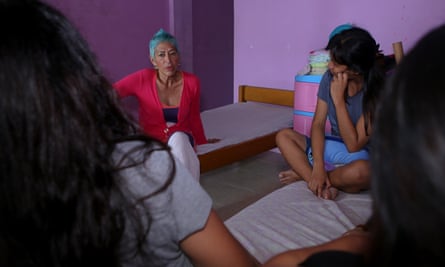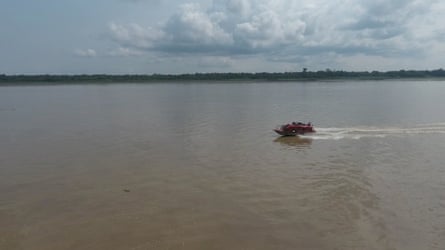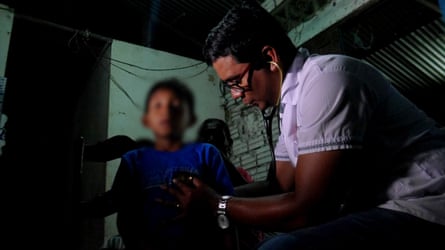As the serpentine Amazon river meanders through a sea of jungle, a little red boat speeds across its muddy brown waters. Powered by two outboard motors, the vessel carries a cargo of volunteers, medics and nurses, an awning, and dozens of HIV screening tests.
The first stop is Nueva Vida Yahua, an indigenous village 40 minutes down the Nanay river from Iquitos. The women are dressed in red skirts and grass tops worn draped over their shoulders, the men in long grass skirts and headdresses made from blue macaw feathers.
As volunteers erect a canopy over a plastic table and chairs, a queue of people begins to form for the finger-prick HIV tests. Village elders use a megaphone to summon more people for the visit by the Aids Healthcare Foundation (AHF).

Alongside the tests, team leader Silvia Barbarán talks frankly to a group of young women – many of them breastfeeding infants or caring for toddlers - about the importance of safe sex and condom use. The women are curious, as though it’s the first time anyone has ever talked to them about safe sex or HIV.
The tests take just 15 minutes to show results: no one in this small hamlet is HIV positive. The mood is jubilant as the volunteers are led to the maloca, the village’s principal palm-thatched hut. The head man, Anselmo Cahuachi, stands in the centre, singing a plaintive song and beating a drum as the villagers dance in a circle around him, each one holding a visitor by the hand.
It is difficult to rush anything in Peru’s largest state, Loreto. At the heart of this swathe of Amazon basin is Iquitos, the largest city in the world that cannot be reached by road.
One of Peru’s poorest regions, with the highest levels of infant malnutrition and anaemia, Loreto now faces a growing threat from HIV and Aids. The virus has spread throughout the vast region since the first reported case in the early 1990s, and particularly affects sex workers, traders, oil workers and indigenous communities.
According to the epidemiological control department of Peru’s health ministry, infection rates in Loreto are exceeded only by Peru’s capital, Lima, and its port district Callao, despite the population of the Amazon region being a fraction of the size.
While Lima and Callao have a combined population of nearly 11 million, Loreto’s inhabitants number less than 1 million. Between 2000 and 2018, around 72,000 cases of HIV and 30,000 cases of Aids were recorded in Lima and Callao. Data from the same period placed Loreto in third place, with roughly 6,000 cases of HIV and 4,000 of Aids.

To counter the rising figures, HIV activists are taking to the river to detect and treat the virus and spread the safe sex message.
“The geography of our jungle is a big problem for getting around,” says Barbarán, Iquitos’ most recognisable and vocal activist for HIV awareness and LGBT rights. “Thanks to this boat we’re saving lives, because with an early diagnosis we can give prompt treatment and that person can get on with their life.”
Barbarán, whose turquoise hair is styled into a quiff, has been HIV-positive since 2000 and came close to death. Treatment in Peru has improved dramatically in the past two decades, and in 2004 the country introduced free antiretroviral (ARV) treatment. Barbarán managed to get ARV treatment soon after she was diagnosed, thanks to relatives who lived abroad.
Since the rubber boom at the beginning of the 20th century, Iquitos has been a trading post. Add to that tourism and more internal movement and “some infections which didn’t exist in the region begin to enter,” says Dr José Luis Sebastián, director of AHF for the Andean region.
“As these are small circles it’s felt in a much stronger way than in regions with a bigger population,” he adds.
Of the more than 4,000 people tested for HIV in Loreto by AHF between January and August, 5.8% have tested positive, which is slightly higher than health ministry figures.
As dusk falls, the team is taken by noisy motorised rickshaws to the home of one of their youngest patients, in nearby Padre Cocha. Leonidas, eight, contracted HIV from his parents.

Abandoned by his mother, Leonidas was adopted by his aunt Micaela Aquituari when his father – her brother – died from Aids in 2014. He lives with Aquituari, a health administrator, and his doting grandparents in a concrete shack with open blue wooden shutters. Electric cables hang off a discoloured wall, on which hangs a photo of Leonidas in his school uniform.
“My brother died and we were very sad, but we have hope for life through his son,” says Aquitari. “For us [my brother] lives through his son for as long as God wishes and we will carry on his treatment so he continues to have a long and happy life.”
Antiretroviral treatment pulled Leonidas back from the brink of death in 2014. He must take large, hard-to-swallow tablets each day for the rest of his life. He wants to be a doctor when he’s older.
Dr Carlos Benites, who leads Peru’s HIV and Aids control programme, says indigenous populations living in the Amazon have certain risk factors due to local customs and practices.
“Beginning sexual relations early, the custom of having more than one sexual partner … the use of condoms is very low,” Benites explains. Some Amazon groups believe they contract HIV because someone has cursed them, he adds.
After Nueva Vida Yahua, the boat travels on to Tamshiyacu. The craft has been named ‘Angely’ after a girl in a remote village who died of Aids because she did not get treatment.
In a torrential downpour, José Roca runs down the concrete steps to the riverside wearing hotpants and a soaking red T-shirt to help unload the boat. Roca, a former sex worker who runs a hair salon, has lived with HIV for more than two decades.

“I knew what I was getting into,” Roca says of contracting HIV. “The pain was not for me, the pain was for my family.”
Peru’s male LGBT community is the demographic most impacted by the virus.
Barbarán admits that sometimes she feels powerless to stop the virus’ advance. “You have to tell people to love themselves and take care of themselves,” she says. She and colleague Lupe Chistama talk frankly about safe sex to a group of young mothers and teenage girls. If a suitor asks you for a “test of your love”, you ask him for his “HIV test”, she jokes.
Loreto has Peru’s highest teenage pregnancy rate. In 2017, more than 30% of 15 to 19-year-old girls became mothers or got pregnant for the first time, almost three times the national average of 13.4%.
Barbarán cares for a 14-year-old girl and her baby son at a centre she set up for HIV positive children in Iquitos. The baby was not infected with the virus when he was born, but Barbarán worries that the problem of transmission is all too common in remoter parts of the region. The girl came from an indigenous community in Requeña, on the region’s south-eastern border with Brazil.
“We hear from the health service that many mothers don’t collect their antiretroviral treatment … I don’t know if it’s culture or negligence,” she says, a note of desperation in her voice. “We have to focus on the mothers.”
Back in Iquitos, the team unload the Angely into waiting motorised rickshaws on the dock. Thoughts are already turning to the next trip along the Amazon and its myriad tributaries. The goal is to reach even more people, says Barbarán, no matter how arduous the journey.
